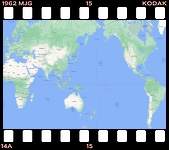An early start got me to Cusco station in time. I got a window seat on the right, in a carriage which was mostly foreign travellers. My carriage, at least, wasn’t too uncomfortable – it was arranged in a “sociable” way with seats in sets of 4, facing each other across a table. At my table were Rhonda from the USA, and 2 Israeli girls. They had brought lots to eat and kept sharing things with me. Also a food cart went up and down the train pretty well non-stop.
The scenery was very wild and there were many stops at places which didn’t seem to have any buildings nearby, yet people still got on and off. Many people could be seen clinging to the outside of the train further down – it wasn’t clear if this was out of necessity or because it was more fun. The day wore on as the 400 km separating Puno from Cusco gradually slipped by – always at a very sedate pace.
A bit of high drama occurred when the train stopped at Juliaca. It later became apparent that the locomotive had to disconnect, to be changed for another one, or perhaps it had to go to the other end of the train. It was just dark by this time and when the locomotive was disconnected the carriage was suddenly plunged into darkness. Almost immediately I could hear a slight commotion a couple of tables up. Someone then turned on a flashlight and revealed 2 very surprised would-be thieves, tugging desperately at 2 backpacks that were (as they had just discovered) tied securely to the luggage rack above the seats. They immediately ran off, leaving the owners of the backpacks – some Irish travellers – very relieved. As usual I, too, had taken the precaution of attaching my backpack to the luggage rack, by clipping the hip belt and tying the loose ends of the shoulder straps round a bar.
At 9 pm the train finally rolled into Puno and after getting a room in the cheap and simple “Uros” hotel, I went with Rhonda to look for some dinner and we found a restaurant in a nearby hotel.
A late start the following morning (5th January) was followed by a leisurely breakfast with the 5 Irish people who hadn’t quite had their backpacks stolen. My plan was to visit the nearby floating islands, which the guide book said were not to be missed. A group of French people at the hotel had the same idea so we all went to the dock and found a boatman willing to take us. The negotiation for the price was long and hard, but eventually everyone was happy and we set off towards the strange yellow line that appeared to divide the large bay in which Puno sits, from the rest of Lake Titicaca.
It wasn’t a fast boat and it was 45 minutes before we arrived at the Uros Islands. The sight that met my eyes was very very odd. I hadn’t been quite sure what to expect. “Floating reed islands” the book had insisted “with people permanently living on them”. I hadn’t really been able to imagine this in advance, and if I hadn’t then seen the phenomenon with my own eyes, I would have had trouble believing that such a thing could exist.
The islands were extensive – it wasn’t just one but many, with channels and reed beds dividing them. We appeared to have come to one of the larger islands – at least the one in the immediate vicinity with the most buildings. There was some indication that it was the “capital” since there was a post office, and telecommunication office.
And it was all floating! Well, kind of. Someone explained that the islands don’t move nowadays – in fact some touch the lake bed, and would be hard to move. The reeds at the bottom gradually disintegrate and are replaced through the diligent efforts of the inhabitants who build up the top of the island with fresh dry reeds from the reed beds. Walking on the island was strange – my feet felt they were sinking perhaps 5 cm into the surface as I walked.
Everything seems to be made of reeds, the boats, the houses, the “carpets”… There is a tower that you can climb to have a view out over the islands. The original reason for the reed islands was apparently defensive – the Uru people could move the islands to safer areas if attacked.
Some small amount of agriculture happens on the islands – I found a few pigs having a siesta, and also what looked like crops growing.
After a couple of hours attempting to let it all soak in, I located the French people again, and our boatman, and we all got taken back to the now excessively normal-looking town of Puno. After a siesta, I wandered up a hill with an overlook and good view of Puno and Titicaca. I got chatting to 2 people who claimed they were poets by profession. I had never met a poet before! Later I ended up at the “International Restaurant” which had a decent chop suey, and I got chatting to an Irishman from the train group.
Back at Hotel Uros, I now need to decide what do do next. Tomorrow, 6th January, I was thinking of heading on towards the Bolivian border, but people keep telling me about an island in Lake Titicaca called Amantaní, which is apparently a bit of a backpacker hangout. If I go to the island I’ll then need to return to Puno, which isn’t ideal – the best thing would be if I could go straight from the island across to Bolivia on the other side of the lake, but apparently that is not possible. Bolivia sounds so exotic… but I have time to experience Titicaca. I shall see how I feel tomorrow.


